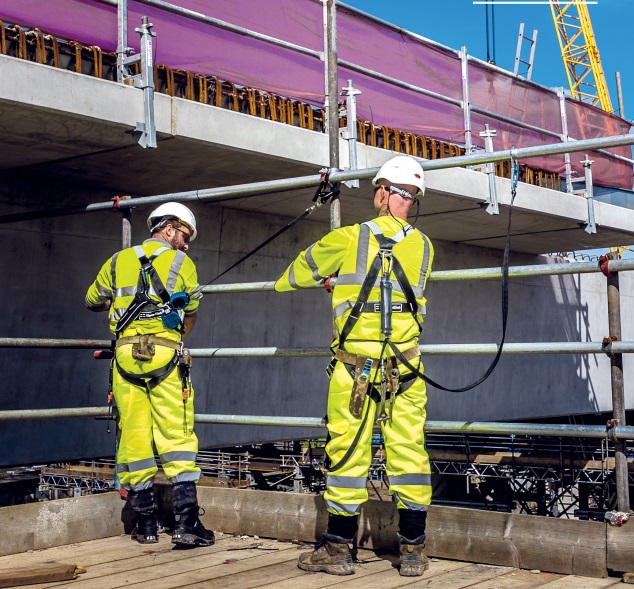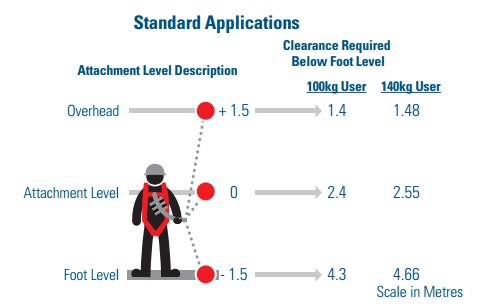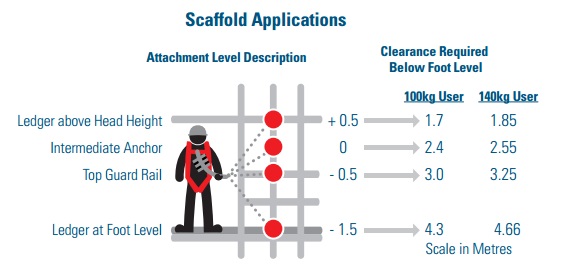Dynamic self-retracting lanyard
Dynamic self-retracting lanyards (DSL) are safety devices used for working at height. They work by minimising the fall distance, which in turn reduces the distance taken to dissipate the energy while keeping the forces created to a safe and acceptable level. This ensures that users are protected against falls from height, the injuries resulting from collisions with hazards and the forces exerted by the safety equipment.
A new milestone was achieved by SpanSet UK, with their 2016 launch of DSL 2. This delivers a 50% improvement compared to the fall clearance requirements set out in BS EN 355:2002 Personal protective equipment against falls from a height – Energy absorbers.
The product builds upon the original DSL by reducing safe clearance heights even further.
The problems associated with falling relate to both the freefall distance and the arrest distance.
The greater the freefall distance, the longer the arrest distance, but the more likely it is that there will be collisions with obstacles or a surface. Previously, lanyards could only provide the choice of freedom of movement or security, but were incapable of providing the right length for each task that would keep the potential fall to the minimum.
The DSL 2 is suitable in situations where there is low clearance and a lack of overhead anchorages (such as scaffold construction). It retracts exactly like a Fall Arrest Block but can be used as an Energy Absorbing Lanyard, anchored anywhere from below foot level to overhead. As a hybrid of Fall Arrest Blocks and Energy Absorbing Lanyards, the DSL 2 provides a balance in that the risks of stopping too quickly or too slowly are ameliorated.
In testing, the DSL 2 arrested falling completely before a conventional lanyard even became taut. The DSL 2 has been tested for users up to 140 kg.
[edit] Related articles on Designing Buildings Wiki
Featured articles and news
RTPI leader to become new CIOB Chief Executive Officer
Dr Victoria Hills MRTPI, FICE to take over after Caroline Gumble’s departure.
Social and affordable housing, a long term plan for delivery
The “Delivering a Decade of Renewal for Social and Affordable Housing” strategy sets out future path.
A change to adoptive architecture
Effects of global weather warming on architectural detailing, material choice and human interaction.
The proposed publicly owned and backed subsidiary of Homes England, to facilitate new homes.
How big is the problem and what can we do to mitigate the effects?
Overheating guidance and tools for building designers
A number of cool guides to help with the heat.
The UK's Modern Industrial Strategy: A 10 year plan
Previous consultation criticism, current key elements and general support with some persisting reservations.
Building Safety Regulator reforms
New roles, new staff and a new fast track service pave the way for a single construction regulator.
Architectural Technologist CPDs and Communications
CIAT CPD… and how you can do it!
Cooling centres and cool spaces
Managing extreme heat in cities by directing the public to places for heat stress relief and water sources.
Winter gardens: A brief history and warm variations
Extending the season with glass in different forms and terms.
Restoring Great Yarmouth's Winter Gardens
Transforming one of the least sustainable constructions imaginable.
Construction Skills Mission Board launch sector drive
Newly formed government and industry collaboration set strategy for recruiting an additional 100,000 construction workers a year.
New Architects Code comes into effect in September 2025
ARB Architects Code of Conduct and Practice available with ongoing consultation regarding guidance.
Welsh Skills Body (Medr) launches ambitious plan
The new skills body brings together funding and regulation of tertiary education and research for the devolved nation.
Paul Gandy FCIOB announced as next CIOB President
Former Tilbury Douglas CEO takes helm.
UK Infrastructure: A 10 Year Strategy. In brief with reactions
With the National Infrastructure and Service Transformation Authority (NISTA).

























